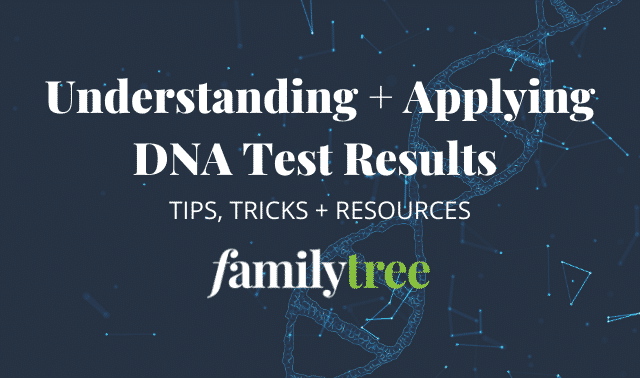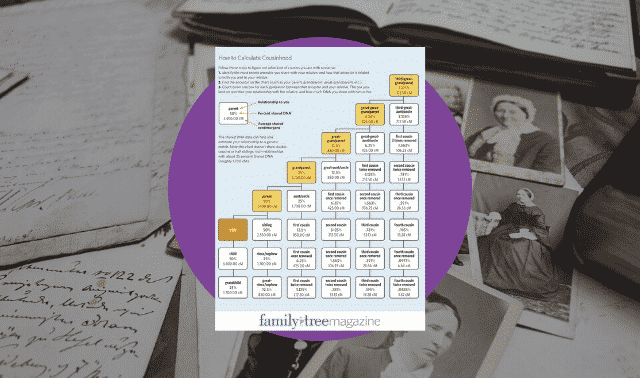Sign up for the Family Tree Newsletter! Plus, you’ll receive our 10 Essential Genealogy Research Forms PDF as a special thank you.
Get Your Free Genealogy Forms
"*" indicates required fields

Should I link my family tree to DNA results? How do I do it?
Q: Why should I add my family tree information to my DNA test? Does the testing company use that information to tell me who my cousins are?
A: As genetic genealogy expands to include many who haven’t yet done any genealogical research, it’s important to understand the role of your family tree in DNA testing.
But first things first: No, the testing company doesn’t take into account any pedigree chart you might post as it makes estimations of your relationships to others in the database. The relationship ranges you see in your test results—such as second to fourth cousin, or even a solid third cousin—are the company’s best guess at your relationship with your match, based on only how much DNA you have in common. So, your pedigree chart isn’t required for accurate relationship estimates.
But associating a pedigree chart with your DNA account does serve two main purposes: First, it helps others help you. By that, I mean that if your pedigree is readily accessible to your matches (meaning it’s linked to your test and it’s public), you can catch your matches while they’re in research mode. Your pedigree chart presents the information you have about your family to your matches at exactly the moment they need it: when they’re online looking at their DNA matches.
If a match has to email you to request access to your tree or ask you to share family names and places, your response might come through when the person is occupied with other activities or the excitement of discovering a new match has worn off. It’s a missed opportunity. If your pedigree is available, on the other hand, instead of a match asking you for genealogy information, she might begin by telling you how you’re connected. Wouldn’t that be nice?
Second, linking a family tree to your DNA test lets you take advantage of the analysis tools your testing company offers. Here’s a quick rundown of how each company is trying to help you make connections with your matches when you post your genealogy information:
AncestryDNA
Linking your DNA results to a public tree on Ancestry.com activates shared ancestor hints. These appear on a match if the site identifies a person in your tree who also appears in the tree of your DNA match. The best way to view these hints is in Ancestry’s ThruLines tool. This allows you to click on one of your ancestors and review all of your DNA matches who have this ancestor in their tree. It also activates the shared location and shared surname features that can also be helpful when determining how you are related to someone else. Lastly, you can link a match in your DNA match list to their place in your family tree. When you do that, a fancy button appears that will let you view that connection later (just in case you forgot).
Family Tree DNA
Here, you can upload a GEDCOM file containing your family tree data (you can generate a GEDCOM from your genealogy software or from many online tree websites). This will allow others to open the GEDCOM in their genealogy software and examine it for matching surnames and places. And if you fill out the surnames and locations tab in your account settings, the site will double-check your list against the surnames your matches enter, and then highlight the matching surnames in the Ancestral Surnames column of your main matches page. You then can focus on these lines for a shared genealogical connection. You can also link your matches to their rightful places on your tree to help you keep everyone organized.
MyHeritage
When you link your MyHeritage family tree to your DNA results, the site employs its Smart Matching technology to compare your tree with your matches’ trees and displays the individuals who overlap. This is super-sized in a feature called The Theory of Family Relativity where MyHeritage pulls in data from trees and genealogical records to give you a head start on discovering how you might be related to your DNA match.
23andMe
Even at 23andMe where genealogy tools are basically non-existent, you can edit your profile to indicate your surnames and locations of origin, and in the “more about yourself” section you can post a link to an online family tree.
It’s easy to build a tree one relative at a time at AncestryDNA or MyHeritage. You also could create a tree in genealogy software such as Legacy Family Tree, RootsMagic or Family Tree Maker, then export a GEDCOM file for upload to AncestryDNA, MyHeritage or Family Tree DNA. If you’re not comfortable putting your entire family tree online, make a simple “skeleton” tree with just your ancestors’ names and their dates and places of birth and death. That’s enough to help matches estimate when and where your common roots might lie—possibly leading to a bigger family tree for both of you.
Related Reads
Updated: July 2021










